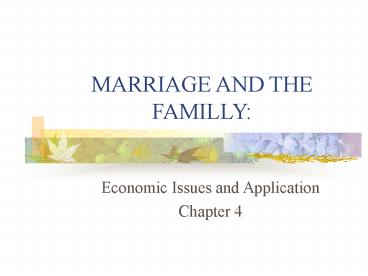MARRIAGE AND THE FAMILLY: - PowerPoint PPT Presentation
Title:
MARRIAGE AND THE FAMILLY:
Description:
this marrige can be save! no rearrengement of output within the marriage can make one party better off than if single without making other worse off. – PowerPoint PPT presentation
Number of Views:130
Avg rating:3.0/5.0
Title: MARRIAGE AND THE FAMILLY:
1
MARRIAGE AND THE FAMILLY
- Economic Issues and Application
- Chapter 4
2
RACE AND FAMILY STRUCTURE
- Does Race Impact Households forming a Family
- The Answer is YES
- It can be seen in your text, Table 4.1
3
RACE DIFFERENCES IN MARITAL AND FAMILY STATUS,
2002
4
RACE DIFFERENCES IN MARITAL AND FAMILY STATUS
- This difference leads to two questions
- When did these differences develop?
- Why did they develop?
- It is clear from the graph in your text Fig 4.1
that there has been a big difference in the
percentage of married women since 1950
5
PROPORTION OF WOMEN AGE 15 AND OLDER, MARRIED, BY
RACE, 1950-2002
6
RACE DIFFERENCES IN MARITAL AND FAMILY STATUS
- Clearly in the mid 60s thru perhaps the 1980s
- So then the question is WHY?
- One possibility is the Rate of Divorce
- The graph 4.2 in your text
7
CHANGES IN THE MARITAL STATUS OF BLACK WOMEN,
1950-2002
8
RACE DIFFERENCES IN MARITAL AND FAMILY STATUS
- Clearly it appears the NEVER MARRIED accounts for
more than the Divorced category - Furthermore Female Householders Increased.
- Or in other words, number of children raised in
two parent household decrease during this same
period
9
CHILDREN UNDER AGE 18 IN TWO-PARENT FAMILIES BY
RACE, 1960-2002
90 80 70 60 50 40 30
WHITE BLACK
1960 1970 1980 1990
2000
10
Is family structure an Economic Issue
- Family structure is currently a very heated
social issue - It has some economic implications in that some
structures are likely to have a given economic
status - Again from your text table 4.2
11
FAMILY INCOME AND POVERTY STATUS OF INDIVIDUALS
BY FAMILY STRUCTURE AND RACE, 2000
12
Economic Explanations for the Divergence in the
Marital Status of White and Blacks
- Marriage Market
- Womens Wage Rates
- The Welfare System
13
Marriage Market
- In Chapter 3, we saw that there is a surplus of
White Males (shortage of white females) and - A surplus of Black and Hispanic females (shortage
of Black and Hispanic males) - That comparison however, may not be specific
enough to determine the marriage market
14
Marriage Market
- Mid 1980s sociologist William Julius Wilson wrote
two books that become standard in the literature
The Truly Disadvantage and When Work Disappears.\ - In The Truly Disadvantage he argues that low
skilled jobs decreased and consequently the job
prospects of many Black Males decreased - Consequently, the marriage prospects of Black
females decrease as well
15
Marriage Market
- William Julius Wilson developed
- the Male Marriageable Pool Index
16
MMPIs BY AGE, RACE, AND YEAR
17
THE MMPI AND THE PROPORTION OF FAMILIES HEADED BY
WOMEN, 1960-80, BY RACE
18
Womens Wage Rates
- The impact can be
- The closer female/male wage ratio the less the
benefits for the female (and even the male) from
marriage - Higher the female wages the higher the
opportunity cost of marriage - An example of this can be found in the data from
Mexico presented below
19
Women Marital StatusIn Mexico
20
Women Marital StatusIn the State of Baja
California
21
Women Marital StatusIn the State of San Luis
Potosi
22
Not Married Women
23
Married by Type of Marriage
24
Non-Married Status(other than never married)
25
The Welfare System
- Welfare system in the US has its broad origins in
the Social Security Act of 1935 - At the time, a program labeled ADC (Aid to
Dependent Children) - The Program was later changed to AFDC (Aid to
Families with Dependent Children)
26
The Welfare System
- It was not until the late 1950s that the Federal
Government started to reimburse states for
participating in AFDC - In the 1960s as part of the War on Poverty the
program was expanded and increased the number of
individuals eligible
27
The NEW Welfare
- In 1994, in part due to the public sentiment that
was voiced by the Clinton Administration - TANF (Temporary Assistance Needy Families)
substitute AFDC
28
PROPORTION OF WOMEN AGE 15 AND OLDER, MARRIED, BY
RACE, 1950-2002
Note the Increase
29
Marriage and the Earnings of Men
- Married men generally earn more income that
single man - Even after taking many factors that would be
impacting the difference - So it has received the name of
- The Male Marriage Premium
30
Marriage and the Earnings of Men
- There may be several reason
- The MPL may be the same but employers pay married
man more. This may be possible but not likely in
a competitive market - Two other reasons are based on the assumption
that MPL (MARRIED) gt MPL (SINGLE)
31
Marriage and the Earnings of Men
- MARRIAGE PRODUCTIVITY EFFECT. Here the economies
of scale at the household level allows men to
become more specialized at the work palce - MARRIAGE SELECTIVITY EFFECT. Here the assumption
is that holding all other things constant, men
that married tend to be more industrious, more
responsible, more courteous, etx
32
Marriage and the Earnings of Men
- Korenman and Neumark found that about the The
Male Marriage Premium was about 11 - With about 6 of the 11 coming from the MARRIAGE
PRODUCTIVITY EFFECT and the remained from the
MARRIAGE SELECTIVITY EFFECT
33
Divorce
- There can be gains and losses
- In an economic sense, divorce is the decision of
the opportunity cost between remaining married
and become single again - Again from your Text Table 4.5
34
ILLUSTRATIVE ANALYSIS OF GAINS TO DIVORCE
35
UNCERTANTY, THE GAINS TO MARRIAGE, AND DIVORCE































